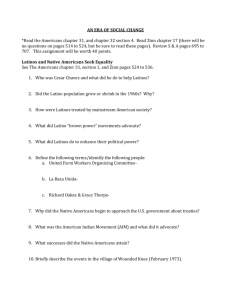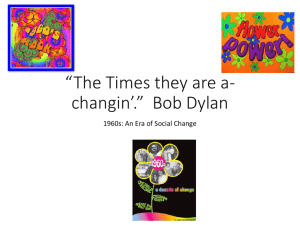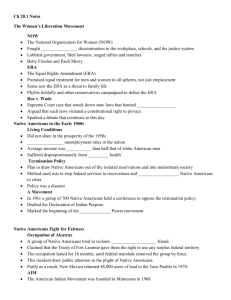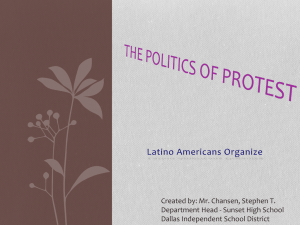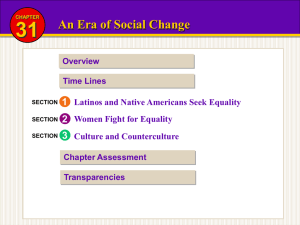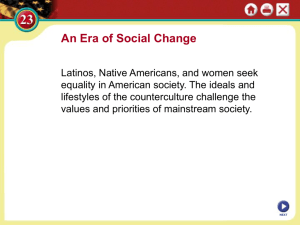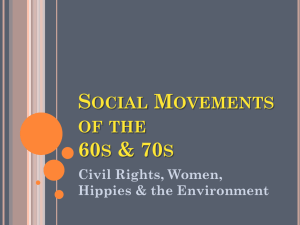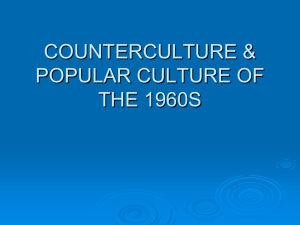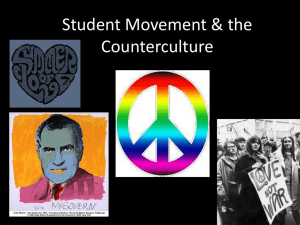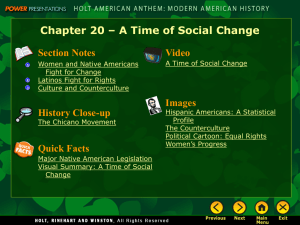Chapter 30: A time of Social Change
advertisement
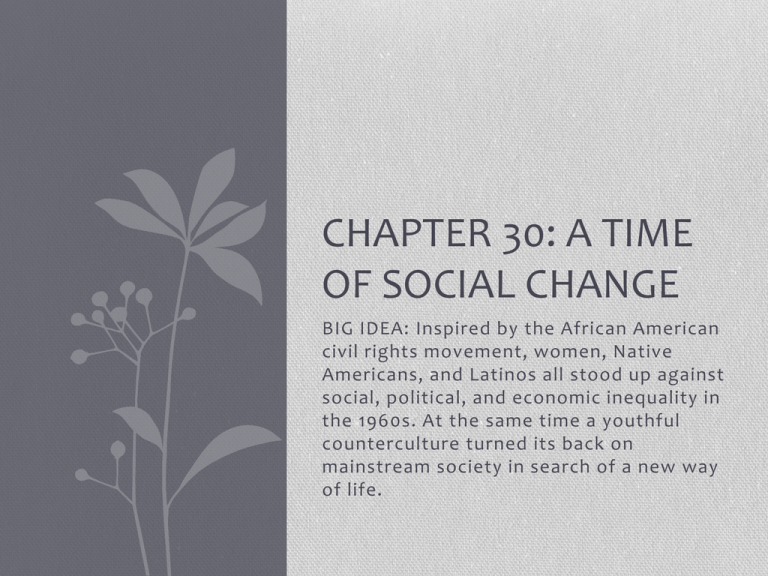
CHAPTER 30: A TIME OF SOCIAL CHANGE BIG IDEA: Inspired by the African American civil rights movement, women, Native Americans, and Latinos all stood up against social, political, and economic inequality in the 1960s. At the same time a youthful counterculture turned its back on mainstream society in search of a new way of life. CHAPTER 30 SECTION 1: WOMEN AND NATIVE AMERICANS FIGHT FOR CHANGE MAIN IDEA: In the 1960s women and Native Americans struggled to achieve social justice. Revival of the Women’s Movement Experiences at work and home Consciousness Raising • Throughout the 1950s-60s, increasing numbers of women joined the workforce (1/3 of workers were women in 1963) • Women earned about 60% of what men made and were excluded from many types of work • 1961 President Kennedy ordered a report about the status of women at work the proved they were being discriminated against • Women still married young (20 was the average) and frequently did not work when they married • Not all women were happy to stay home; Betty Friedan wrote The Feminine Mystique in 1963 detailing how trapped many women felt by being homemakers and mothers • Women organized groups called consciousness raising groups to discuss problems unique to middle class women and common patterns of discrimination • Many were upset to find discrimination even in movements to end discrimination like the African American Civil Rights Movement. The Women’s Liberation Movement NOW The Equal Rights Amendment • Women began organizing around an idea known as feminism: women should be socially, politically, and economically equal • NOW actively campaigned for passage of the Equal Rights Amendment (ERA) that would guarantee equality in all spheres of life, not just employment • It passed Congress and had to be ratified by at least 38 states • After making good gains initially, it ran into opposition with conservatives, especially in the South • Phyllis Schlafly was an outspoken critic who was concerned that women would loose privileges they held if the amendment passed • the ERA was unable to get enough votes to ratify it by the 1982 deadline, and it was not added • Civil Rights Act of 1964 banned discrimination based on sex but was not well enforced • 1966: a group of feminists led by Betty Friedan formed the National Organization for Women (NOW) to fight discrimination, end violence against women, and fight for abortion rights • They work to pass laws, filed lawsuits, and staged rallies and marches The Women’s Liberation Movement Roe v. Wade Effects of the women’s movement • 1973: Supreme Court strikes down state laws banning abortion as a violation to the constitutional right to privacy • This case remains one of the most controversial decisions ever rendered by the court • By the end of the 1970s the number of women holding professional jobs increased, but most still had low wages • 1970 5% of lawyers women and by 1980, 12% of lawyers women • Women started running for and winning seats in Congress • Many perceived the movement as only benefiting white middle and upper class women The Lives of Native Americans • Native Americans did not share in the prosperity of most Americans in the 1950s and had the highest unemployment rate in the nation • Most lived in poverty and rates of disease and alcoholism were high as well • During the Eisenhower administration, the federal government tried end the reservation system through a policy called termination: ended the reservation system and encouraged Native Americans to move to cities and join mainstream society • Was a failure because the government did not provide services to support them; they often ended up worse off • Native Americans met in 1961 to organize a movement to oppose termination and other polices that harmed Native Americans Native Americans Fight for Fairness Occupation of Alcatrez & AIM Other Organizations & Assessing Progress • President Johnson supported selfdetermination for Native Americans (created National Council on Indian Opportunity) • 1969 Native American activists tried to reclaim Alcatrez Island, an abandoned federal prison (held for 18 months and forcibly removed by police) • Led to the creation of American Indian Movement (AIM): wanted a renewal of traditional culture, economic independence, and better education) led by Russell Means • Most of the protests were nonviolent, but some like an occupation of Wounded Knee ended violently • Other groups emerged to work towards other needs for Native Americans • There were many legislative victories (increased health care, education, religious freedom, and educational opportunity) • Despite these accomplishments, unemployment remained high as was the high school drop out rate CHAPTER 30 SECTION 2: LATINOS FIGHT FOR RIGHTS MAIN IDEA: In the 1960s Latinos struggled to achieve social justice. The Lives of Latinos • 1960: 900,000 Latinos lived in the US • Immigration increases because the Immigration Act of 1965 gave preference to immigrants with relatives already in the US • 1/3 lived below the poverty line; 80% worked in low-paying unskilled work like farm labor, construction, and factory work • There was discrimination in schools and 75% of Latino students dropped out of high school • District lines were drawn to limit the political power of Latinos and they were often excluded from juries Launching the Struggle for Social Justice • Latinos began organizing for social justice: fair distribution of advantages in society • Migrant farm workers are the first to organize • 1965 farmer workers led by Cesar Chavez led a strike and a national boycott on grapes to force the farm owners to recognize the farm workers’ union • They wanted better pay and better working conditions • Their strike was successful and encouraged other Latino Americans to fight for rights Movements for Latino Rights Defining the Chicano Movement Alianza • Some Latinos adopted rhetoric like the Black Power movement and called themselves Chicanos (a shortened form of Mexicanos) to convey ethnic pride and political activism • They thought the term Mexican American indicated assimilation • Some leaders focused on land issues • Alianza Federal de Mercedes worked to get land that had been seized from Mexican Americans by the federal government at the end of the Mexican American War • Their leader was arrested and the movement broke up Movements for Latino Rights The Crusade for Justice • Led by Rodolfo “Corky” Gonzalez, the Crusade for Justice promoted Mexican American nationalism • They provided legal assistance, cultural awareness, a Spanish language newspaper, and ran a school with free bilingual and culture classes MAYO • 1967 College students in Texas form Mexican American Youth Organization • They wanted economic independence, local control of education for Hispanic children, and power for Latinos through a 3rd party • They organized mass walkouts in schools to protest discrimination • Many schools began to reform as a result of the protests Movements for Latino Rights La Raza Unida The Brown Berets • After working with MAYO, Jose Gutierrez formed La Raza Unia (the United People) • They campaigned for bilingual education, public services, education for children of migrant workers, and an end to job discrimination • It spread throughout the Southwest and some branches were able to elect members to local government • Formed in the late 1960s, the Brown Berets were the most militant of the groups that formed • Founded by working-class Latinos in LA in 1967, they focused protest on police brutality and later adopted other causes like ending discrimination in schools • They disbanded in 1972 after a series of violent demonstrations Movements for Latino Rights The Boricua Movement Cuban Americans • Boricua is a term for Puerto Ricans • This term also expresses ethnic pride and support for political activism • Many Puerto Ricans migrated to mainland US after World War II (9% of NYC population by 1964) • Their goals included independence for Puerto Rico, but that did not gain much support, even among Puerto Ricans • They fared better with antidiscrimination goals • After the communist revolution, many well-to-do Cubans fled to the US and many more continued to flee Cuba • Most came to the US for political reasons, not economic ones • Most of their movements focused not on social justice, but for the overthrow of Castro and an end to communism in Cuba CHAPTER 30 SECTION 3: CULTURE AND COUNTERCULTURE MAIN IDEA: The counterculture that emerged in the 1960s and 1970s left a lasting impact on American life. Rise of the Counterculture The Youth Culture Rising Student Activism • Counterculture: a rebellion by teens and young adults against mainstream American society • They viewed American values as hollow and misplaced & turned their back on the Establishment (mainstream culture) • Developed due to the large number of youth (Baby Boom)— up 50% between 1960 and 1970 • Blamed their parents for all of the societal problems (Vietnam, racism, nuclear war, pollution) • College students began by protesting against policies they viewed as restrictive and unjust • University of CA-Berkley protested new bans on free speech and demonstrations (called the Free Speech Movement) and these demonstrations spread to college campus’ throughout the nation Life in the Counterculture Hippie Culture The counterculture’s Decline • Thousands of teens and young adults abandoned mainstream culture and became hippies • Some formed communes and the Haight-Ashbury district of San Francisco became the center of hippie culture • Major values were peace and love (shared what they had) • Had a reputation for drug use (esp. LSD) and colorful clothes • Sometimes referred to as flower children • Height of the movement was the 1967 Summer of Love • Woodstock (1969) major concert celebrating the counterculture • Movement declined due to drug use/abuse and a lack of support (many parents refused to keep funding the lifestyle) Mainstream Society Reacts • Many mainstream Americans viewed hippies as disrespectful, uncivilized, and threatening • They feared it was a sign that America was loosing its sense of right and wrong • TV show All in the Family highlighted the conflict between hippies and mainstream society The Counterculture’s Legacy Attitudes/Art • America became more permissive and causal • Sexual activity and violence on TV and in movies became more prevalent • Pop art began appealing to wider audiences • Andy Warhol did art of mass produced culture (Marilyn Monroe, Campbell’s Soup) • Ratings system for movies was developed Music • Music became more political • Artists like Bob Dylan, the Beatles, and Joan Baez wrote songs focused on criticism of the government and society in general
